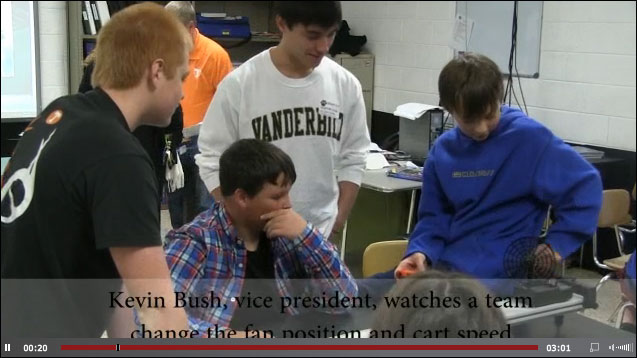Brandon Dimmig steadies a fan cart for a cluster of eager fifth graders. The fan cart looks like a toy and students are instantly attracted to the straight grey track and the small black cart with a movable fan.

“If we keep the fan on the same speed and we add some extra weight to it, will the cart move faster or slower down the track?” asks Dimmig. “Slower!” they said in unison and giggled. “What if we remove the weight?” “Faster!” they said, again in unison and a little louder.
“Right,” Dimmig said. “A heavier cart needs more force to move the same distance down the track than a lighter cart. That’s Newton’s second law of motion. Acceleration is produced when a force acts on a mass. The greater the mass – or weight of the cart – the greater the amount of force needed to move the cart.”
“This is really fun. I learned that mass does affect time and distance,” said Brandon Boles. Katie Arms said she learned that “rockets are awesome.”
Dimmig is a senior mechanical engineering student and president of the Vanderbilt Aerospace Club. Dimmig and seven other club members spent a Friday in late October at the Celina K-8 School in Clay County, Tenn., about 100 miles northeast of Nashville. They split teaching duties between fifth, seventh and eighth grade science classes, using frictionless fan carts and plastic soda bottle rockets to teach Newton’s laws of motion, to help explain rocket design, and to spark an interest in rocketry and engineering.
“The teachers said they had never seen students this actively engaged,” said Dimmig, who teamed with Jordan Salik, a senior mechanical engineering major and the club’s computational fluid dynamics engineer, in fifth grade teacher Donatta Birdwell’s morning science classes. Club members worked with seventh and eighth graders in teacher Gary Tinsley’s science classes. Salik said the teachers were eager to modify their lesson plans to better engage students.
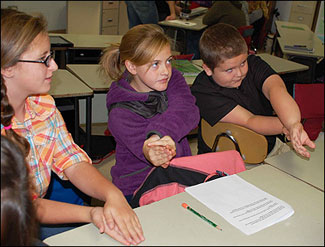
“Every student was participating. That’s not always the case,” Birdwell said.
Before the school day was over, Dimmig, Salik, and mechanical engineering seniors Kevin Bush, Patrick Foran, Shiva Bernath, Chris Twedell; junior Fred Folz, and outreach coordinator Toshia Wrenn, a Ph.D. student in chemistry, had worked with more than 160 students in Celina, Tenn., one of only two K-8 schools in Clay County, a small county with about 7,800 residents, on the Tennessee-Kentucky border.
“It is an ideal setting for an outreach activity,” said A.V. Anilkumar, the club’s adviser and professor of the practice of mechanical engineering. “Generally, students who live in sparsely populated counties with fewer public schools aren’t exposed enough to the fun of engineering design.”
The trip to Celina is part of an award-winning comprehensive educational outreach program the Aerospace Club designed and has offered to select under-served middle schools.
The club’s primary activity is participating in NASA’s annual Student Launch competition, which involves building a high-powered 10-foot rocket, equipping it with several onboard science payloads, designing it so it flies as close as possible to one mile in altitude and then parachutes safely back to earth. The SL competition also requires an educational engagement component.

In 2012 the club won NASA’s Educational Engagement Award for its efforts to inspire young students in the study of rocketry and other science, technology, engineering and mathematics (STEM) related topics. As they had last year, the club partnered with Heather Johnson, assistant professor of the practice of science education in the Department of Teaching and Learning in Vanderbilt’s Peabody College of Education and Human Development.
Johnson leads the Peabody side of the project and guides the engineering students as they design new experiments and develop lesson plans they present and then leave with middle school science teachers to incorporate into their curriculum.
“Our lesson plan begins with a brief introduction and how we became interested in engineering and rocketry. We show a rocket launch video. Then, we describe how the students will use three fan cart experiments to answer the question, ‘How do we get our rocket to reach a mile high?’” said Dimmig.
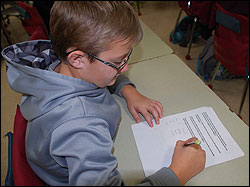
Small groups of about five students get a fan cart, a stopwatch and worksheets that allow them to make predictions and to record their data during each of the three experiments.
The first experiment introduces Newton’s third law, and action-reaction concepts, by asking students to record the time it takes the cart to cross the track with the fan set to three different speeds. The second experiment illustrates Newton’s second law by allowing students to add mass to the cart and record the time it takes to cross the track at a constant fan speed. The third experiment demonstrates Newton’s first law. The fan is set on a one-second delay. The students note how the cart acts before the fan is on, while the fan is on, and after the fan has stopped.
“After the experiments are finished, we help them apply what they learned to rocketry. An engineer must be conscious of the amount of force the rocket motor creates, the mass of the rocket, and the length of time for which the rocket motor burns,” Salik said.
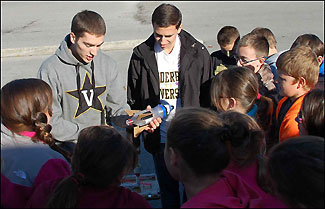
While less effusive than the fifth graders, the eighth grade students were equally curious about the hands-on experiments. They were more efficient in conducting the three experiments, which left time for groups to devise their own experiments. Inclining the track using school books, varying the mass and the fan speed and pivoting the fan proved to be popular choices in several of the small groups.
“We covered Newton’s laws in class but I understood it much better using the fan cart,” said Seth Ogletree.
His classmates agreed. “It’s good to do actual experiments,” said Kendal Johnson. “Aerodynamics matters.”
When the eighth graders grew quiet during a concluding discussion in the classroom, Chris Twedell said, “Who likes Legos? I love Legos! I still play with Legos.” The class erupted. “That’s what I’m going to do as an engineer. I’m going to play with adult Legos.”
“Hands-on engineers bring unique perspectives to teaching physics,” Professor Anilkumar said. “They establish the science-engineering-technology link.”
The team plans to visit another school in Clay County and two schools in Perry County, reaching nearly 600 students and a dozen teachers by the end of their outreach program in May. Vanderbilt Aerospace Club activities are jointly sponsored by the Tennessee Space Grant Consortium and Vanderbilt’s Department of Mechanical Engineering.
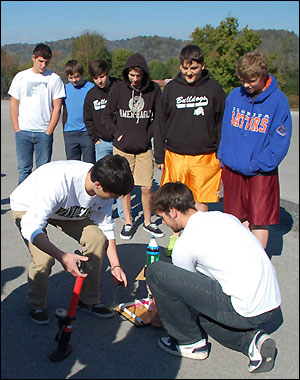
The teachers noticed something, too. “They saw lower-performing students’ attention really increase during the lessons … something they hadn’t seen so far this semester,” said Patrick Foran, one of the club’s design engineers.
The final experiment in all classes clearly was the favorite. Despite a chilly morning temperature that didn’t improve throughout the sunny day, students grabbed coats and gathered in the ample parking lot to launch water-filled bottle rockets. Usually two bold students helped club members prepare the launch stand. All students joined in the countdowns.
“Rocketry is a direct demonstration of Newton’s third law where the action of pushing the water out of the bottle rocket at high speeds generates thrust on the rocket,” said Shiva Bernath, the club’s website manager.
More lessons ensued as flights varied due to different amounts of water in the bottles and more or less pressure from a bicycle pump used with the launch mechanism. Although watching from a safe distance, some students felt a wet mist when one rocket veered slightly in their direction, responding with loud whoops and laughter.
“We were able to show them that science and engineering needn’t be reserved for old guys in lab coats,” said Bernath. “This is a [career] path that is accessible and fun.”
![]()
Vanderbilt takes top prize in NASA student rocket launch challenge
Team’s payload design tops fourth consecutive year at NASA rocket contest
